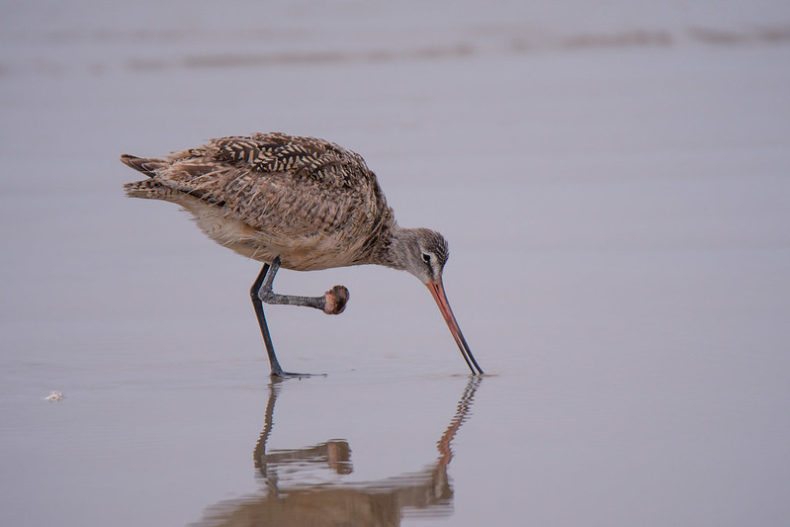
In March, when the boys and I started walking at the beach every morning, I decided I would re-learn the names of shorebirds. Not the gulls—even the professor who originally taught me the names of shorebirds said not to worry too much about gulls. But the other ones, the ones with the w’s in their names. The curlew, the whimbrel, the willet, the godwit.
Some of them have curved beaks, some of them have straight beaks, some of them have cinnamon wings, some of them have tell-tale calls. I don’t really remember how to memorize things like this anymore, so I try to use a combination of mnemonics and mental self-flagellation.
I learn that the marbled godwit is one of the bigger shorebirds, its straight bill has a slight upward tilt toward the end. It spends summers in the northern Great Plains and comes to the coast in the winter. The godwit is often seen with the long-billed curlew. Here we go: similar color to the godwit, but the bill curls down. That’s it, I think, curlew = curls down.
And then I remember the whimbrel. Its bill also curls down. True, its bill is not quite as dramatic as the as the long-billed curlew’s. But if the two species are not standing next to each other, what am I supposed to do? I wish they would skitter up on their thin legs and introduce themselves. Usually they are all skittering away from us.
Another thing that we’ve been doing a lot of, these past weeks, is playing board games. (I should say the third thing we’ve been doing a lot of is Minecraft. Mostly, the boys are doing it and I am trying to get them to stop so that we can go for a walk.)
One of my least favorite board games is Chutes and Ladders. It’s entirely by chance that you win or lose—you flick the spinner and it sends you forward through a checkerboard obstacle course. Each ladder has an image of a child doing a good deed at the bottom. If you land here, your piece climbs up the ladder to reach the happy outcome at the top. Sweep up a mess, and you’ll get to go to the movies; plant seeds in the garden, and you’ll have beautiful flowers in a vase. Spin the wrong number, though, and you’ll slide down as you perpetrate crimes like stealing from a cookie jar, or trying to skate somewhere with a sign that says “thin ice.”
I’m not sure if the point is to teach children what to do and not do. Some of the images are confusing. A girl carrying a stack of dishes drops them and falls, and slides halfway down the board. But what if she was taking them to the sink after dinner? What if she had washed them all herself?
Or is the game saying that it’s all up to chance? Spin the wheel: you hide a comic book behind your history textbook and sink down to the bottom. Spin again: you win the game. Sometimes, when one of us wins too soon, we start to play backward, taking the slides back down to the start, trying to avoid the ladders that will bring us back up. Here, the game is stacked against us. The “winning” space, in our reverse game, is the beginning of a ladder, so as soon as you land, you have to climb back again.
Let’s take a break from the games, from Minecraft, let’s take another walk around the block. One bird that I can identify that has a w in it is crow. On Friday, we were walking around the block and we saw a dead one on the sidewalk. It had downy feathers around its breast, although the wings were black and shiny. A trail of ants was streaming toward it, and away. It was the youngest crow I’d ever seen.
That’s so sad, the boys said. Their faces went still. Where did it come from? How did it happen?
“It came from that nest,” my youngest son said.
What nest? He pointed. There it was, in the top of the tree. At least two feet wide and we’d never seen it before, even though we’ve walked under that tree many times before.
How did it happen? We couldn’t stop asking this. We came up with stories—hawks, missing parents, trying to fly too soon. We made up a song for the crow and how it was helping the ants grow.
“We’ve been seeing a lot of dead birds,” said another of the brothers. There have been many, at least one or two every day on the beach. The dead birds have been mostly cormorants, or the nameless gulls. I haven’t seen any of my mixed up shorebirds. I remember that there is one thing that I can grasp on to about the whimbrel—it has a stripe of darker feathers near its eye, like the mask a bandit would wear. Whimbrel, whimsical, wearing a mask. It would be whimsical to have to wear a mask every day, wouldn’t it?
On Friday we talked about why we’re seeing more dead birds—they would usually be at school, so we wouldn’t be out walking so much. We all thought about this for a while. “It’s good to be paying attention,” a brother said. Then they all ran back to the house to start building their own worlds again, worlds where they were the ones who decided exactly what happened.
*
Image of a whimbrel by Flickr user troy williams, Creative Commons license.